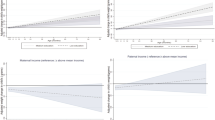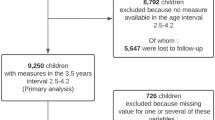Abstract
Objective:
To examine the extent to which early child nutrition, maternal antenatal lifestyle behaviours and child diet and lifestyle explain social class inequalities in the risk of rapid weight gain between birth and 3 years and obesity at age 3 years.
Design:
A longitudinal and prospective birth cohort study.
Subjects:
Nationally representative sample of 11 134 children and their parents followed from 9 months of age until 3 years. Child weight and maternal height and weight were measured at 9 months and 3 years and child birth weight was extracted from hospital records. Other predictors of child growth and obesity were collected by maternal report at 9 months and 3 years.
Results:
Although born lighter on average, children of unskilled manual parents were 274 g heavier than children of professional parents by 3 years of age. The fully adjusted model of rapid growth from birth to 3 years of age and obesity at 3 years of age accounted for all social class differentials. Breastfeeding and age at the introduction of solids were associated with the largest average reduction (41%) in the odds ratio (OR) of rapid growth in the first 9 months of life for each class relative to the professional class. In the period from 9 months to 3 years of age, the class differential in rapid growth was reduced most by measures of the child’s diet and lifestyle. However, the impact of the groups of predictors varied by social class. For early life growth, among the non-manual classes the proportionate reductions are largest when adjusted for early infant nutrition, whereas maternal prenatal smoking is more important for the manual social classes.
Conclusion:
Preventative interventions to reduce levels of childhood obesity should be multi-dimensional but different dimensions should be given more or less significance depending on socio-economic group.
This is a preview of subscription content, access via your institution
Access options
Subscribe to this journal
Receive 12 print issues and online access
$259.00 per year
only $21.58 per issue
Buy this article
- Purchase on Springer Link
- Instant access to full article PDF
Prices may be subject to local taxes which are calculated during checkout

Similar content being viewed by others
References
Wang Y, Lobstein T . Worldwide trends in childhood overweight and obesity. Int J Pediatr Obes 2006; 1: 11–25.
Popkin BM, Conde W, Hou N, Monteiro C . Is there a lag globally in overweight trends for children compared with adults? Obesity 2006; 14: 1846–1853.
WHO. Reducing Risks, Promoting Healthy Life. World Health Organistion: Geneva, 2002.
Serdula MK, Ivery D, Coates RJ, Freedman DS, Williamson DF, Byers T . Do obese children become obese adults? A review of the literature. Prev Med 1993; 22: 167–177.
Power C, Lake JK, Cole TJ . Measurement and long-term health risks of child and adolescent fatness. Int J Obes Relat Metab Disord 1997; 21: 507–526.
World Health Organisation. Global Strategy on Diet, Physical Activity and Health. World Health Organisation: Geneva, 2004.
Summerbell CD, Ashton V, Campbell KJ, Edmunds L, Kelly S, Waters E . Interventions for treating obesity in children. Cochrane Database Syst Rev 2003; 3: CD001872.
Oude Luttikhuis H, Baur L, Jansen H, Shresbury VA, O’Malley C, Stolk RP et al. Interventions for treating obesity in children (Review). Cochrane Database Syst Rev 2009; 1: 1–175.
Sobal J, Stunkard AJ . Socioeconomic status and obesity: a review of the literature. Psychol Bull 1989; 105: 260–275.
Wang Y, Zhang Q . Are American children and adolescents of low socioeconomic status at increased risk of obesoty? Changes in the association between overweight and family income between 1971 and 2002. Am J Clin Nutr 2006; 84: 707–716.
Stamatakis E, Primatesta P, Chinn S, Rona R, Falascheti E . Overweight and obesity trends from 1974 to 2003 in english children: what is the role of socio-economic factors? Arch Dis Childhood 2005; 90: 999–1004.
Stamatakis E, Wardle J, Cole TJ . Childhood obesity and overweight prevalence trends in England: evidence for growing socio-economic disparities. Int J Obes 2010; 34: 41–47.
Ogden CL, Carroll MD, Kit BK, Flegal KM . Prevalence of obesity and trends in body mass index among US children and adolescents, 1999-2010. J Am Med Assoc 2012; 307: 483–490.
Olds T, Maher C, Zumin S, Peneau S, Lioret S, Cestetbon K et al. Evidence that the prevalence of childhood overweight is plateauing: data from nine countries. Int J Paediatr Obes 2011; 6: 342–360.
Danielzik S, Czerwinski-Mast M, Langnase K, Dilda B, Muller MJ . Parental overweight, socio-economic status and high birth weight are major determinants of overweight and obesity in 5-7 y-old children: baseline data of the Kiel Obesity Prevention Study (KOPS). Int J Obes 2004; 28: 1494–1502.
Von Kries R, Toschke A, Koletzko B, Slikker W . Maternal smoking during pregnancy and childhood obesity. Am J Epidemiol 2002; 156: 954–961.
Griffiths LJ, Smeeth L, Hawkins SS, Cole TJ, Dezateaux C . Effects of infant feeding practice on weight gain from birth to 3 years. Arch Childhood Dis 2009; 94: 577–582.
Reilly JJ, Armstrong J, Dorosty AR, Emmett M, Ness A, Rogers I et al. Early life risk factors for obesity in childhood: cohort study. Br Med J 2005; 300: 1357–1359.
Oken E, Taveras EM, Kleinman KP, Rich-Edwards JW, MW GIllman . Gestational weight gain and child adiposity at age 3 years. Am J Obstetr Gynecol 2007; 196: 322.
Taveras EM, Rifas-Shiman SL, Sherry B, Oken E, Haines J, Kleinman K et al. Crossing growth percentiles in infancy and risk of obesity in childhood. Arch Pediatr Adolesc Med 2011; 165: 993–998.
Cole TJ, Belizzi MC, Flegal KM, Dietz WH . Establishing a standard definition for child overweight and obesity worldwide: international survey. Br Med J 2000; 320: 1–6.
Ong KK, Ahmed ML, Emmett PM, Preece MA, Dunger DB . Association between post-natal catch-up growth and obesity in childhood: prospective cohort study. Br Med J 2000; 320: 967–971.
Sallis JF, Taylor WC, Dowda M, Freeson PS, Pate RR . Correlates of vigorous physical activity for children in grades 1 through 12: comparing parent-reported and objectively measured physical activity. Pediatr Exerc Sci 2002; 14: 30–44.
Cameron N . Growth patterns in adverse environments. Am J Hum Biol 2007; 19: 615–621.
Singhal A, Fewtrell M, Cole TJ, Lucas A . Low nutrient intake and early growth for later insulin resistance in adolescents born preterm. Lancet 2003; 361: 1089–1097.
Griffiths LJ, Dezateux C, Hill A . Is obesity associated with emotional and behavioural problems in children? Findings from the Millennium Cohort Study. Int J Pediatr Obes 2010; 6: 1–10.
DCYA. Growing Up in Ireland: Infant Cohort (at 3 years). In. The Health of 3 Years Olds. Department of Children and Youth Affairs: Dublin, 2012.
Baird J, Fisher D, Lucas P, Kleijnen J, Roberts H, Law C . Being big or growing fast: systematic review of size and growth in infancy and later obesity. Br Med J 2005; 331: 929–931.
Monteiro PO, Victoria CG . Rapid growth in infancy and childhood and obesity in later life: a systematic review. Obes Rev 2005; 6: 134–154.
Taveras EM, Rifas-Shiman SL, Belfort MB, Kleinman KP, Oken E, GIllman MW . Weight status in the first six months of life and obesity at 3 years of age. Pediatrics 2009; 123: 1177–1183.
GIllman MW . Early infancy as a critical period for development of obesity and related conditions. In: Lucas A, Makrides M, Ziegler E (eds) The Importance of Growth for Health and Development. Nestle Nutrition Institute Workshop: Boston, MA, 2010. pp 13–24.
Cameron N, Pettifer J, De Wet T, Norris S . The relationship of rapid weight gain in infancy to obesity and skeletal maturity in childhood. Obes Res 2003; 1: 457–460.
Mei Z, Grummer-Strawn LM, Thompson D, Dietz WH . Shifts in percentiles of growth during early childhood: analysis of longitudinal data from the California Child Health and Development Study. Pediatrics 2004; 113: 617–627.
Kramer MS . Determinants of low birth weight: methodological assessment and meta-analysis. Rev Analyses 1987; 65: 663–737.
Beyerlein A, Ruckinger S, Toschke M, Schaffrath Rosario A, Von Kries R . Is low birth weight in the causal pathway of the association between maternal smoking in pregnancy and higher BMI in the offspring? Eur J Epidemiol 2011; 26: 413–420.
Toschke A, Ehlin AG, Von Kries R, Ekbom A, Montgomery SM . Maternal smoking during pregnancy and appetite control in offspring. J Perinatal Med 2003; 31: 251–256.
Ong KK, Preece MA, Emmett PM, Ahmed ML, Dunger DB . Size at birth and early childhood growth in relation to maternal smoking, parity and infant breast-feeding: longitudinal birth cohort study and analysis. Pediatr Res 2002; 52: 863–867.
McCrory C, Layte R . Prenatal exposure to maternal smoking and childhood behavioural problems: a Quasi-experimental approach. J Abnorm Child Psychol 2012; 40: 1277–1288.
McCrory C, Layte R . Breastfeeding and risk of overweight and obesity at nine-years of age. Soc Sci Med 2012; 75: 323–330.
Kenkel DS, Lillard DR, Mathios AD . Accounting for misclassification error in retrospective smoking data. Health Econ 2004; 13: 1031–1044.
Tarrant RC, Younger KM, Sheridan Periera M, Kearney JM . Factors associated with breastfeeding in ireland: potential areas for improvement. J Hum Lact 2011; 27: 262–271.
Tarrant RC, Younger KM, Sheridan-Pereira M, White M, Kearney JM . Factors associated with weaning practices in term infants: a prospective observational study in Ireland. Br J Nutr 2010; 104: 1544–1554.
Acknowledgements
The Growing Up in Ireland data have been funded by the Government of Ireland through the Department of Children and Youth Affairs; have been collected under the Statistics Act, 1993, of the Central Statistics Office. The project has been designed and implemented by the joint ESRI-TCD Growing Up in Ireland Study Team. In addition to the funders, we thank the entire Growing Up in Ireland Project and Study teams, and the children and families who participated in the study.
Author information
Authors and Affiliations
Corresponding author
Ethics declarations
Competing interests
The authors declare no conflict of interest.
Rights and permissions
About this article
Cite this article
Layte, R., Bennett, A., McCrory, C. et al. Social class variation in the predictors of rapid growth in infancy and obesity at age 3 years. Int J Obes 38, 82–90 (2014). https://doi.org/10.1038/ijo.2013.160
Received:
Revised:
Accepted:
Published:
Issue Date:
DOI: https://doi.org/10.1038/ijo.2013.160
Keywords
This article is cited by
-
Mediators of socioeconomic differences in overweight and obesity among youth in Ireland and the UK (2011–2021): a systematic review
BMC Public Health (2022)
-
Reducing fetal origins of childhood obesity through maternal smoking cessation during pregnancy: an intervention study
International Journal of Obesity (2019)
-
Effects of parent and child behaviours on overweight and obesity in infants and young children from disadvantaged backgrounds: systematic review with narrative synthesis
BMC Public Health (2016)
-
Connecting the Dots in Childhood Obesity Disparities: a Review of Growth Patterns from Birth to Pre-Adolescence
Current Epidemiology Reports (2016)



